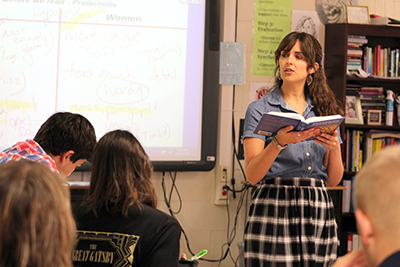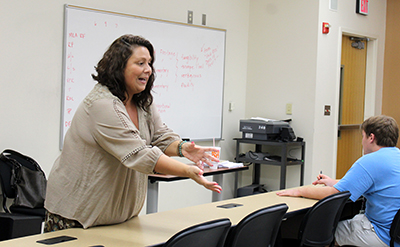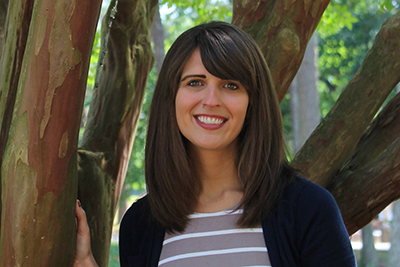by Amy K. Lavender
“I didn’t know I could think like this!”
Those were the words of one of Jessica Bohlen’s students when he saw the changes in his test scores after spending nine weeks using Inquiry Based Learning in Temple High School’s 10th grade World Literature class.
The trial run was part of a study Bohlen did in partnership with University of West Georgia professors Dr. Rebecca Harrison and Dr. Angela Insenga and Mt. Zion Elementary School teacher Heather Giebeig. Their aim was to find out if students at the high school, middle school, and elementary level would respond well to Inquiry Based Learning (IBL), a teaching method that has been around since the 1970s and is based on the Scientific Method. Since its development, IBL has only been implemented at the collegiate level. The thinking was that it wasn’t an appropriate teaching method for younger students.

However, what the study discovered is that not only could younger students understand and participate in the IBL method, they could greatly benefit from it. Bohlen’s class saw an overall improvement of 492 percent at the end of the nine-week study. Bohlen, a UWG alumna, described the experience as nothing short of transformational for her students.
“I saw so much improvement in my students,” Bohlen said. “[When I was looking at the post-test], I was so excited that I started going through the pre-test to do a side-by-side comparison, and I thought, ‘Oh my gosh! This is fantastic.’ When I gave the tests back to them, they got to see what they did and we went over it. The kids talked about how proud they were of themselves.”
Bohlen also noted that most of her students began performing better in their other classes, presenting fewer behavioral issues and displaying more confidence in their ability to learn and think critically. And other teachers in her school have begun to take notice, as well.
Reaching the Community
“Since the study, I’ve been doing in-services for my fellow teachers,” Bohlen said. “I had one this year with English teachers, but other teachers have been coming in from other disciplines to get advice on this as well.”
Seeing the effectiveness of the method and the students’ eagerness to apply the same method in their other classrooms, teachers from a variety of disciplines at Temple High have now begun incorporating aspects of IBL in their lesson plans, effecting roughly 450 students.
Harrison said this was one of the main purposes of the study: not just to see the results of the study but also to see how those results could help teachers.
“It’s about building those connective threads in meaningful ways between college faculty and teaching faculty, and not in ways where we’re saying, ‘This is how to do it,’ but rather ‘How can we help you develop under the parameters you have?’” Harrison said. “That’s really the focus for creating change–building those inner connections between two different worlds.”
She and Insenga said their goal is to form a meaningful partnership in the community to allow information and discoveries at the collegiate level to flow freely to teachers in the field.
However, they also hope to use the study’s results to change attitudes about IBL.

“Bohlen’s findings challenge some of the presumptions that we might have about IBL,” Insenga said. “This idea that lower level students can’t handle IBL, that they don’t have the ability to ask questions for higher thinking, is something that [Jessica’s] experience rules out. It is a small study, so there are limitations to some of the findings, but the level of increase with her particular experience really shocked and pleased us.”
A Pleasant Surprise
The results from Bohlen’s class were particularly surprising because it wasn’t an honors or AP class. In fact, some of her students had learning disabilities.
“Her data surprised us all. [Jessica’s] was the most challenging application, and it would require, I believe, the most careful curating and pacing, especially for students who have particular needs,” explained Insenga. “In those collaborative classes, you have students who are learning challenged for whatever reason along with very high-performing students, so there are several kinds of challenges you might face that you have to accommodate for.”
Bohlen herself agreed that it was more work up front for her to begin IBL instruction in her classroom–and it seemed like a daunting task–but the payoff was worth it.
“Originally, I was terrified of it,” Bohlen recalled. “But I decided that it was only nine weeks, and I could fix whatever happened, and I’m so glad I did it. I see so much improvement in those students with me teaching that way rather than simply teaching them my interpretation.”
Giebeig recalls experiencing a similar surprise using IBL in her 5th grade honors class. She already had the books, but they had been sitting on the shelf for quite some time. Then, one day, the class had finished their lesson early, and she decided to give the method a shot since they were so far ahead.
“Their eyes just lit up, and I had not seen that before,” Giebeig recalled. “That very day I knew I needed to change everything I was doing. I realized that inquiry wasn’t just for reading, but could be for other subjects. That’s when things finally took off, and it was like a light went on for me.”
When Harrison and Insenga realized that a local teacher was using IBL in her elementary classroom, they were intrigued to say the least.
“What really blew me away was watching [Heather] do it with second, third, and fourth graders,” Harrison said. “That was remarkably eye opening. I think for both of us we saw that it could actually go all the way down.”
Real-World Impact
According to Harrison and Insenga, incorporating IBL at all levels could improve graduation rates as well as college and career readiness.
“So what if we started to think about what someone learns in 5th grade and maybe again in 8th grade and maybe again in 10th grade,” Insenga said. “What if we started to see a through line all the way through college? Is there a thread there? And not just an anecdotal one. Or is there a kind of bulleted thread we can create?”
Insenga and Harrison contend that this could be done with closer collaboration between institutions of higher education and K-12 faculty.
“We need stronger bridges that marry those two worlds together¬–the worlds of discipline and faculty who are in the discipline¬–looking at innovative ways to teach,” Harrison explained. “I think we should all be looking for ways to bring the university and our local community together as a whole.
They admit that IBL could fundamentally change the way teachers instruct, across all disciplines, and this could sound a little dismaying to professionals who are already making changes to adapt to curriculum changes. But Insenga said IBL could actually help teachers who are struggling to find a way to prepare students for standardized tests.

“If you just look at the verbs in Common Core, you’ve got ‘analyze,’ ‘examine,’ ‘investigate,’ and these are all terms that ideally would make our students work well at the secondary level,” she said. “These are the kinds of problem-solving skills that we say we would like our students to accomplish through Common Core.”
Bohlen agrees, saying IBL has actually helped her prepare her students for the literature portion of the Common Core standardized test.
“For English and literature, you don’t know what text they’ll be given on the test,” she explained, “but with IBL, they go in feeling like they can tackle anything. They know what questions to ask, how to answer them, and how to think critically about the text on their own.”
Harrison and Insenga said they would like to launch a larger study in the future to see what kind of results they would get with a larger group of students. Even more helpful, would be a long-term study that follows students taught with the IBL method as they progress through their education.
“This could really be a success story for the whole state,” said Insenga, “to not only improve students’ ability to learn, but to also prepare them for careers and college, and fundamentally change the way they think about school and learning. It’s really very exciting.”
Posted on